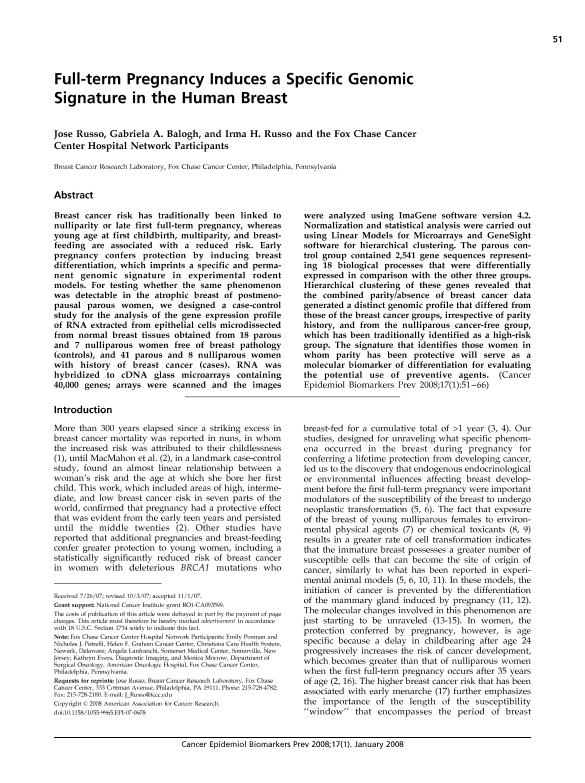Mostrar el registro sencillo del ítem
dc.contributor.author
Russo, José
dc.contributor.author
Balogh, Gabriela Andrea

dc.contributor.author
Russo, Irma H.
dc.contributor.author
Fox Chase Cancer Center Hospital Network Participants
dc.date.available
2017-07-11T19:16:31Z
dc.date.issued
2008-01-16
dc.identifier.citation
Russo, José; Balogh, Gabriela Andrea; Russo, Irma H.; Fox Chase Cancer Center Hospital Network Participants; Full-term pregnancy induces a specific genomic signature in the human breast; American Association for Cancer Research; Cancer Epidemiology, Biomarkers & Prevention; 17; 1; 16-1-2008; 51-66
dc.identifier.issn
1055-9965
dc.identifier.uri
http://hdl.handle.net/11336/20146
dc.description.abstract
Breast cancer riskhas traditionally been linked to nulliparity or late first full-term pregnancy, whereas young age at first childbirth, multiparity, and breastfeeding are associated with a reduced risk. Early pregnancy confers protection by inducing breast differentiation, which imprints a specific and permanent genomic signature in experimental rodent models. For testing whether the same phenomenon was detectable in the atrophic breast of postmenopausal parous women, we designed a case-control study for the analysis of the gene expression profile of RNA extracted from epithelial cells microdissected from normal breast tissues obtained from 18 parous and 7 nulliparous women free of breast pathology (controls), and 41 parous and 8 nulliparous women with history of breast cancer (cases). RNA was hybridized to cDNA glass microarrays containing 40,000 genes; arrays were scanned and the images were analyzed using ImaGene software version 4.2. Normalization and statistical analysis were carried out using Linear Models for Microarrays and GeneSight software for hierarchical clustering. The parous control group contained 2,541 gene sequences representing 18 biological processes that were differentially expressed in comparison with the other three groups. Hierarchical clustering of these genes revealed that the combined parity/absence of breast cancer data generated a distinct genomic profile that differed from those of the breast cancer groups, irrespective of parity history, and from the nulliparous cancer-free group, which has been traditionally identified as a high-risk group. The signature that identifies those women in whom parity has been protective will serve as a molecular biomarker of differentiation for evaluating the potential use of preventive agents.
dc.format
application/pdf
dc.language.iso
eng
dc.publisher
American Association for Cancer Research

dc.rights
info:eu-repo/semantics/openAccess
dc.rights.uri
https://creativecommons.org/licenses/by-nc-sa/2.5/ar/
dc.subject
Breast Cancer
dc.subject
Prevention
dc.subject
Biomarkers
dc.subject.classification
Bioquímica y Biología Molecular

dc.subject.classification
Ciencias Biológicas

dc.subject.classification
CIENCIAS NATURALES Y EXACTAS

dc.title
Full-term pregnancy induces a specific genomic signature in the human breast
dc.type
info:eu-repo/semantics/article
dc.type
info:ar-repo/semantics/artículo
dc.type
info:eu-repo/semantics/publishedVersion
dc.date.updated
2017-07-10T13:08:11Z
dc.identifier.eissn
1538-7755
dc.journal.volume
17
dc.journal.number
1
dc.journal.pagination
51-66
dc.journal.pais
Estados Unidos

dc.journal.ciudad
Philadelphia
dc.description.fil
Fil: Russo, José. Breast Cancer Research Laboratory. Fox Chase Cancer Center; Estados Unidos
dc.description.fil
Fil: Balogh, Gabriela Andrea. Consejo Nacional de Investigaciones Científicas y Técnicas. Centro Científico Tecnológico Conicet - Bahía Blanca. Centro de Recursos Naturales Renovables de la Zona Semiarida. Universidad Nacional del Sur. Centro de Recursos Naturales Renovables de la Zona Semiarida; Argentina
dc.description.fil
Fil: Russo, Irma H.. Breast Cancer Research Laboratory. Fox Chase Cancer Center; Estados Unidos
dc.description.fil
Fil: Fox Chase Cancer Center Hospital Network Participants.
dc.journal.title
Cancer Epidemiology, Biomarkers & Prevention

dc.relation.alternativeid
info:eu-repo/semantics/altIdentifier/doi/http://dx.doi.org/10.1158/1055-9965.EPI-07-0678
dc.relation.alternativeid
info:eu-repo/semantics/altIdentifier/url/http://cebp.aacrjournals.org/content/17/1/51.full
Archivos asociados
